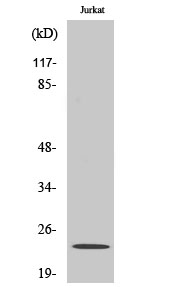Claudin-19 Polyclonal Antibody
- SPECIFICATION
- CITATIONS
- PROTOCOLS
- BACKGROUND

Application
| WB |
|---|---|
| Primary Accession | Q8N6F1 |
| Reactivity | Human, Rat |
| Host | Rabbit |
| Clonality | Polyclonal |
| Calculated MW | 23229 Da |
| Gene ID | 149461 |
|---|---|
| Other Names | CLDN19; Claudin-19 |
| Dilution | WB~~Western Blot: 1/500 - 1/2000. ELISA: 1/10000. Not yet tested in other applications. |
| Format | Liquid in PBS containing 50% glycerol, 0.5% BSA and 0.09% (W/V) sodium azide. |
| Storage Conditions | -20℃ |
| Name | CLDN19 {ECO:0000303|PubMed:25555744, ECO:0000312|HGNC:HGNC:2040} |
|---|---|
| Function | Forms paracellular channels: coassembles with CLDN16 into tight junction strands with cation-selective channels through the strands, conveying epithelial permeability in a process known as paracellular tight junction permeability (PubMed:18188451, PubMed:28028216). Involved in the maintenance of ion gradients along the nephron. In the thick ascending limb (TAL) of Henle's loop, facilitates sodium paracellular permeability from the interstitial compartment to the lumen, contributing to the lumen-positive transepithelial potential that drives paracellular magnesium and calcium reabsorption (By similarity) (PubMed:17033971, PubMed:25555744). Forms paracellular barriers on its own. In the peripheral nervous system, represents a major constituent of the tight junctions in Schwann cells and contributes to electrical sealing. During retinal neurogenesis, may regulate the barrier properties of tight junctions in retinal pigment epithelium, required for proper retinal tissue differentiation and vision (By similarity) (PubMed:17033971, PubMed:30937396). |
| Cellular Location | Cell junction, tight junction. Cell membrane; Multi-pass membrane protein. Note=Cotrafficks with CLDN16 from ER to tight junctions. Colocalizes with CLDN16 and CLDN3 in cell- cell contact areas of the TAL spatially separated from CLDN10b paracellular channels. |

Thousands of laboratories across the world have published research that depended on the performance of antibodies from Abcepta to advance their research. Check out links to articles that cite our products in major peer-reviewed journals, organized by research category.
info@abcepta.com, and receive a free "I Love Antibodies" mug.
Provided below are standard protocols that you may find useful for product applications.
Background
Plays a major role in tight junction-specific obliteration of the intercellular space, through calcium- independent cell-adhesion activity.
If you have used an Abcepta product and would like to share how it has performed, please click on the "Submit Review" button and provide the requested information. Our staff will examine and post your review and contact you if needed.
If you have any additional inquiries please email technical services at tech@abcepta.com.













 Foundational characteristics of cancer include proliferation, angiogenesis, migration, evasion of apoptosis, and cellular immortality. Find key markers for these cellular processes and antibodies to detect them.
Foundational characteristics of cancer include proliferation, angiogenesis, migration, evasion of apoptosis, and cellular immortality. Find key markers for these cellular processes and antibodies to detect them. The SUMOplot™ Analysis Program predicts and scores sumoylation sites in your protein. SUMOylation is a post-translational modification involved in various cellular processes, such as nuclear-cytosolic transport, transcriptional regulation, apoptosis, protein stability, response to stress, and progression through the cell cycle.
The SUMOplot™ Analysis Program predicts and scores sumoylation sites in your protein. SUMOylation is a post-translational modification involved in various cellular processes, such as nuclear-cytosolic transport, transcriptional regulation, apoptosis, protein stability, response to stress, and progression through the cell cycle. The Autophagy Receptor Motif Plotter predicts and scores autophagy receptor binding sites in your protein. Identifying proteins connected to this pathway is critical to understanding the role of autophagy in physiological as well as pathological processes such as development, differentiation, neurodegenerative diseases, stress, infection, and cancer.
The Autophagy Receptor Motif Plotter predicts and scores autophagy receptor binding sites in your protein. Identifying proteins connected to this pathway is critical to understanding the role of autophagy in physiological as well as pathological processes such as development, differentiation, neurodegenerative diseases, stress, infection, and cancer.


